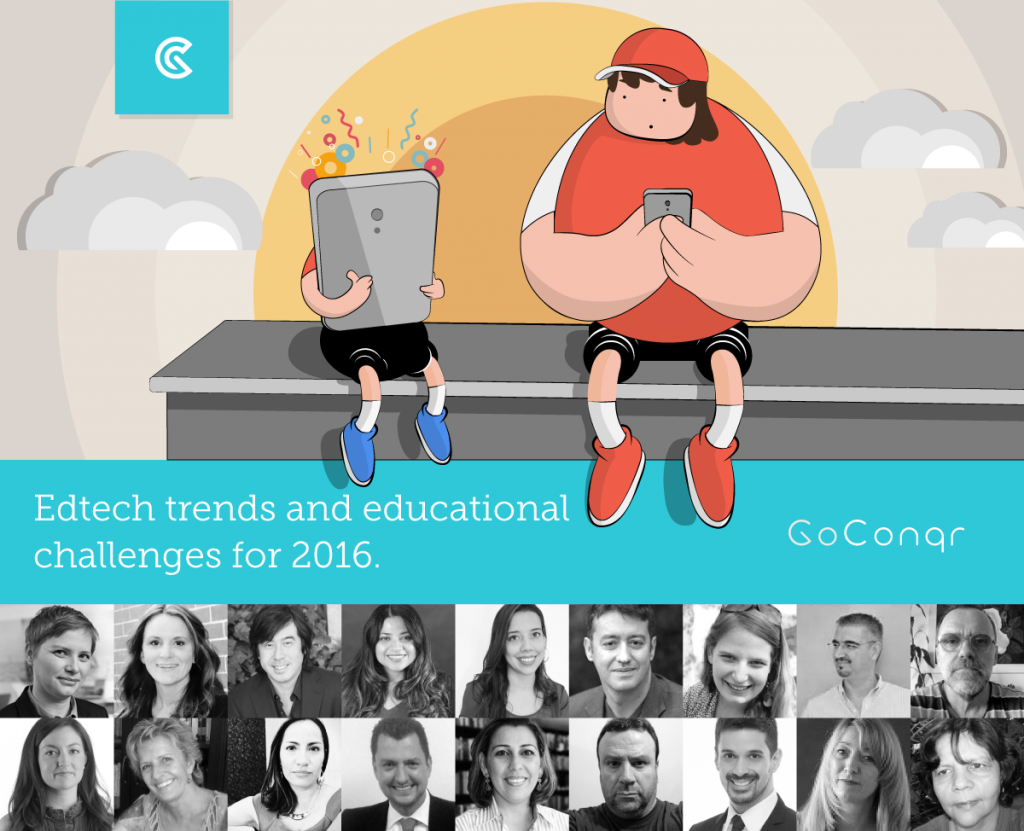2016 is now well underway, but few could say how it will end or what major changes we’ll see as the year unfurls. But that hasn’t stopped us from asking a number of experts in education and technology to gaze into their crystal balls and share their thoughts on one major EdTech trend we can expect to see lighting up learning and one major challenge that education and technology will face in 2016.
Discover GoConqr best resources!
Education and technology – major trends and challenges
1. Shelly Sanchez Terrell (Teacher Trainer and eLearning Specialist, US)
Trend
In 2016, I believe we will see more learners creating, making, programming, coding, producing, innovating, inventing, designing, problem solving and publishing. I believe more schools worldwide will find the funds and way to have their students learn with technology. Some hot topics will be virtual reality, augmented reality, 3D printing, coding and the maker movement. I am excited to see how our learners make the world a brighter place just by adding their own creativity and spark!
Challenge
The challenge we face worldwide is how teachers, parents, leadership, and communities will help learners design intelligently and innovate with compassion. We desperately need citizenship back in the curriculum. We also need less focus on grades and standardizing. We need more focus on providing the room for experimentation and testing of ideas several times without students having to worry it will have high stakes on their grades, admission into college, and future.

2. Jennifer Williams (Programme Developer, US)
Trend
In 2016, I believe the world of edtech will explore new ways to create active learning environments that inspire engagement and innovative thinking. New, flexible spaces will allow for student voice and choice and a co-construction of knowledge. As we begin to see this shift in environment and culture, learners in our schools today will be supported in physical and virtual learning spaces to connect to the world and to their futures.
Challenge
With an increased presence of BYOD and 1:1 programs in classrooms, schools today are faced with the challenge of transforming traditional learning spaces to seamlessly connect pedagogy,education and technology.

3. Savas Savides (Publisher & Former Educator, Greece)
Trend
One of the biggest EdTech trends in 2016 and for the years to follow will be gamification.
The 2016 learner is a digital native with far more education and technology resources at their disposal than ever before. Teachers will have to put up an even bigger fight for their students’ diminishing attention. Gamification will provide the necessary motivation, engage learners, and bring back the fun element in the learning process. Many universities, like Stanford, have caught on to that trend and are already offering courses and degrees in gamification. Educators will soon need to start thinking like game designers if they want to keep their students engaged.
Challenge
The devastating conflicts in the Middle East and the refugee waves seeking shelter in Europe will soon effect education systems all over the continent. Education administrators will need to find ways to integrate refugee populations in the school system in a way that will be both pragmatic and respectful to their ethnic and religious characteristics.

4. Russell Stannard (Educational Technologist, UK)
Trend
There will be a shift in focus from the teacher to the student.
We are seeing far more interest in concepts such as the flipped classroom, which are giving students the capacity to learn outside of the class so that class time is used for higher level skills work, where the new knowledge is applied.
What is also interesting is the use of platforms which allow for complete online delivery. Teachers are gradually learning to use these tools in more innovative and creative ways that involve more interaction and student participation. In fact I am currently working on a Master-level course at a University in Berlin in which there are no formal teacher-led lectures. Instead, all the content is generated by the students, while the professor plays the role of the ‘guide on the side’.
Challenge
The responsibility for learning is shifting, and greater expectations are being put on students. This doesn’t undermine the role of the teacher but it does mean the teacher becoming more of a facilitator. This is a complex role where the teacher may need to guide the students on things like study skills, internet searches, presentations, provide feedback on drafts and more formative guidance. This will require a shift in the way teachers are trained too. The good news is that this process does seem to be happening slowly and so there is time for both students and teachers to adapt to the new ways learning is being organized.

5. Barbara Geyer-Hayden (MA Programme Director, Germany)
Trend
Mobile learning. The most common device among students is the smartphone. It is therefore important that eLearning content is mobile supported. Many online learning platforms can be used with smartphones, tablets, and desktop computers. Web-based classroom solutions also offer apps in most cases.
Challenge
Because mobile learning is a trend, one’s own online content should always be tested for smartphone and tablet use.

6. Monica Burns (Educator and Author, US)
Trend
I just returned from FETC in Orlando and was excited to see how many sessions focused on scannable technology. In 2016 I hope to see more teachers thinking about the thoughtful and purposeful integration of education and technology tools such as QR codes and augmented reality.
Challenge
Preparation is key in any endeavor and teachers should have technology on their mind when they are planning everyday lessons or longer learning experiences. Teachers want to identify what tools will make content more accessible for students with different learning needs and how students can create products with tech tools that will help them build transferable digital skills.

7. Ted Fujimoto (Entrepreneur and Senior Executive, US)
Trend
I think we will see some innovation in competency-based assessment tools and systems partially driven by the flexibility given by ESSA to manage the evaluation of project, portfolios, performance tasks and other student-centered approaches. I am currently working with a few companies and can also tell you that there is exciting next-generation work coming out in the area of integration of music and arts in learning that will blow your mind.
Challenge
Nationally, only 25% of students today are receiving the education and technology they need to qualify for a middle class paying job or even be hired by the U.S. military. This past year, the median wage in the US fell below middle class wage levels. This means that 20 years from now, if this trajectory continues, 75% of Americans will not be able to pay for themselves. It is important to transform the educational experience for the majority of American kids within the next 10 years to change this trajectory. We need to do this at scale to pass a tipping point in this transformation. What this means to me is that some 30,000 schools need to be transformed. This is something we are working towards with the American Dream Schools initiative.

8. Maria Mendez (Educator, Chile)
Trend
We will see more and more educational MOOC platforms to replace classroom training, as they afford users universal access to knowledge. It’s easily possible to envision a future where mobile applications are central to learning, allowing students to consume learning material from anywhere, and at any time.
Challenge
Dependence on technological devices has increased exponentially in recent years. It seems that no-one can live without them. Technology has changed the way we live and, therefore, the way we learn.

9. Maria Jesus Viviani (Educator and Author, Spain)
Trend
It is not just students who will benefit from technology entering the classroom. Teachers too will increasingly come to rely on education and technology for planning lessons, communicating with other educators and seeking alternative training.
Challenge
Educators mustn’t view education as being independent of the outside world. Educational services need to incorporate a more holistic or ecological component in their classroom thinking. This extends to civil, political and economic organizations, as well as professionals from different areas who can collaborate and work with both educators and learners.

10. Sérgio Abranches (Maths and Technology Professor, Brazil)
Trend
One of the educational trends for these coming years is the use of active methods in virtual learning environments, where the student is the author of their own learning, working in a collaborative manner. Another trend is the growth of interdisciplinarity, where various areas of knowledge are involved in the production of knowledge.
Challenge
One of the challenges is to overcome the deeply hierarchical nature of education in favor of more collaborative ways and means. Another challenge is the use of multiple languages, overcoming the exclusivity of the written form of learning. Education and technology favors the expansion of the communication between educational actors with the use of new forms of expression, such as video and audio.

About GoConqr
 GoConqr is a free learning platform that helps users overcome classroom obstacles by giving them powerful web-based tools to create, view and share millions of educational resources. Sign up now to join a community of over 2 million learners.
GoConqr is a free learning platform that helps users overcome classroom obstacles by giving them powerful web-based tools to create, view and share millions of educational resources. Sign up now to join a community of over 2 million learners.
Check out all international contributions in full in Spanish and Portuguese.
Contributors
- Shelly Sanchez Terrell (@ShellTerrell) is a teacher trainer, elearning specialist and author. She has trained teachers and taught learners in over 20 countries, has received numerous rewards for her work and is a founder of #Edchat.
- Jennifer Williams (@JenWilliamsEdu) is the co-founder and lead program developer for Calliope Global. She works with schools, universities, and organizations from around the world.
- Savas Savides has been involved in education and technology for more than 20 years. He has worked as a teacher, examiner, teacher trainer, and publisher. He blogs at www.brightclassroomideas.com and shares educational ideas on Twitter at @SSavides.
- Russell Stannard (@russell1955) is an educational technologist with several awards to his name, including the British Council Technology Award.
- Monica Burns (@ClassTechTips) is an EdTech & Curriculum Consultant, Apple Distinguished Educator and Founder of ClassTechTips.com. She is the author of Deeper Learning with QR Codes and Augmented Reality: A Scannable Solution for Your Classroom (available in March 2016).
- Ted Fujimoto is President of Landmark Consulting Group, Inc., a management and investment consultancy for scaling innovations in learning. He co-chairs the Right to Succeed Foundation, a non-profit focused on transforming public education through the creation of at least 6,000 American Dream Schools within the next 10 years. You can follow his work at @tedfujimoto.
- Barbara Geyer-Hayden (@barbarageha) is director of the MA programme Applied Knowledge Management at the University of Applied Sciences Burgenland.
- Maria Mendez (@mariaparrula) has taught Spanish as a foreign language for 10 years. She has authored 6 books on education and technology.
- Maria Jesus Viviani is an early childhood educator and doctor (PhD) in education. She has worked as a teacher trainer and collaborated on numerous research projects. Today is dedicated to the administration of an online platform to support the training of professionals in early childhood education.
- Sérgio Abranches is a professor of Maths and Technology, and a researcher on education and technology with an emphasis on the training of teachers.

